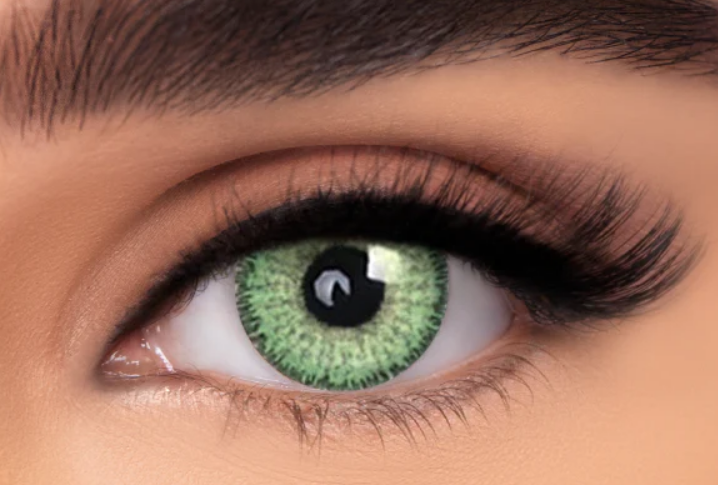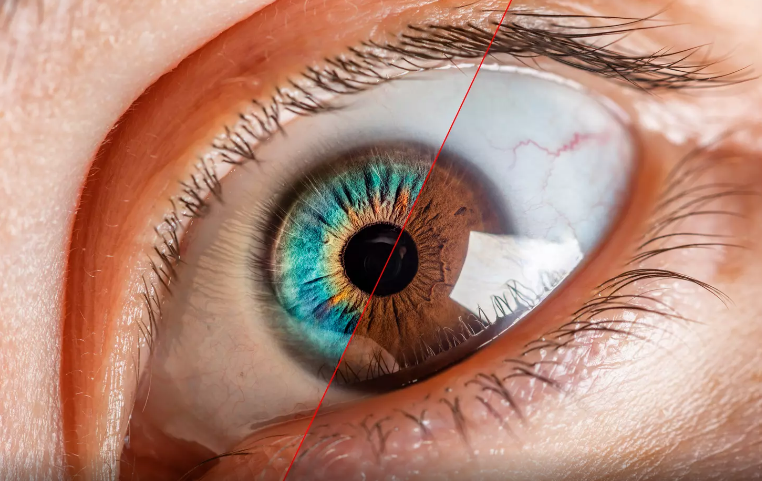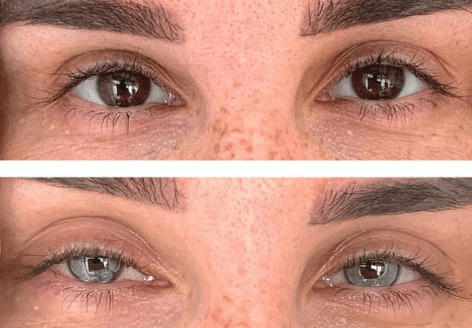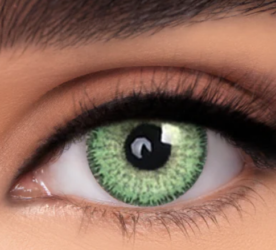Yes, it is possible to change eye color through surgical procedures, but these procedures are highly controversial, not widely accepted in the medical community, and carry significant risks. Changing eye color through surgery typically involves implanting artificial iris devices or using laser treatments to alter the appearance of the iris. However, it’s important to understand the limitations and risks associated with these procedures:

Artificial Iris Implants: Some surgical procedures involve implanting a colored artificial iris device over the natural iris. This is done to change the color of the eye. These implants can be risky and may lead to complications, including vision problems, glaucoma, cataracts, and inflammation. These procedures are generally not recommended and may be illegal in some places.
As the topic is really technical, we would advice to read more about keratopigmentation in general and compare our posts to avoid non safe and too expensive procedures.
Checking simply before after photos and even videos of eye color change procedure is a first step to give you a right indication of what works.
Check out before after photos of Keratopigmentation procedures.
Cosmetic Iris Laser Treatments: There are clinics that claim to offer laser treatments to change eye color by destroying melanin in the iris. The safety and long-term effectiveness of these procedures are not well-established. They may carry risks to your vision and eye health.
Surgical Iris Color Change: Some surgical techniques involve removing a layer of the iris to expose a different layer underneath, which may have a different color. This is a risky procedure and can result in complications, including vision impairment and changes in pupil size.

These procedures should not be undertaken lightly, and they should only be considered after careful consultation with a qualified ophthalmologist or eye specialist. Even then, they are typically discouraged due to the significant risks involved.
It’s essential to remember that the natural color of your eyes is determined by genetics and the amount and type of pigments in your iris. Attempting to change eye color through surgery should only be considered in cases where there are compelling medical reasons, such as treating eye injuries or correcting congenital abnormalities. Cosmetic reasons alone are generally not considered sufficient justification for these procedures.
If you are interested in changing your eye color for cosmetic reasons, a safer and more reversible option is to use colored contact lenses, which can provide a different look without the risks associated with surgery. Always prioritize the health and safety of your eyes when considering any eye color change procedures. That was the basic disclaimer and common sense comments you may find before 2021 before Keratopigmentation surge.
Though safety shall remain the main criteria, now we can easily say in 2023 that eye color change surgery works if all conditions are met.
In short you can have the right eye color change surgery but not everywhere, only in few clinics in the world.
It was said that in 2021 only 2 clinics were performing it, 6 in 2023, about 10 for 2024.

Eye color isn’t the be-all and end-all, and we understand that it doesn’t define one’s personality. However, considering the abundance of positive feedback from both women and men who have undergone the right eye color change procedure, we can confidently say that it has indeed made a significant, even life-changing impact.
For some individuals, their natural eye color may not align with their comfort or self-perceived attractiveness, prompting a desire for change. Eye color is an attribute bestowed by our irises, and nature has painted them in various captivating hues. In rare instances, the color of your eyes can naturally evolve, typically due to medical conditions or environmental factors.
The pigmentation of your eyes can undergo transformations due to factors such as inflammation, trauma, depigmentation, or lifestyle choices. Sun exposure, alterations in melanin levels, and dietary habits can subtly influence the hue of your irises. However, these changes are often barely noticeable. To genuinely and permanently alter your eye color, one must consider a reliable eye color change surgery.
Eye color change procedures have been available for quite some time and have been honed over the past two decades or so. Recently, one particular eye color change technique has reached a level of mastery that makes it readily accessible as a cosmetic procedure.
This technique, which we will delve into further, is only offered by a select few experts worldwide. Consequently, this procedure doesn’t neatly fit into a specific medical category.
Categorizing it as a procedure within the realm of plastic or cosmetic surgery makes sense to some, while others argue that it falls under the purview of ophthalmology.
As the market rapidly evolves, it’s reasonable to assert that, for now, this procedure belongs to ophthalmology. While many procedures can serve medical and cosmetic purposes simultaneously, this procedure is fundamentally an ophthalmological surgery with cosmetic intentions.

The uniqueness of this procedure lies in the fact that plastic surgeons are typically trained to perform body or facial surgeries like fat removal, lipofilling, or rhinoplasty, not this specific type of procedure. It’s considered a hybrid procedure, a blend of facial plastic surgery executed by ophthalmologists.
From time to time, technological advancements and shifting market demands prompt specialists in one medical category to develop expertise in new areas. Dermatologists, for instance, often face heightened demand for skin whitening procedures, even if it doesn’t align precisely with their primary training or focus.
This is pertinent because mastering eye color change procedures necessitates ophthalmological expertise, and the demand is likely to emerge from plastic surgeons. As the market evolves rapidly in 2023, we anticipate collaborations between dedicated ophthalmologists and plastic surgery clinics will emerge as a viable avenue for disseminating these techniques.
Another limiting factor is technology, particularly concerning keratopigmentation, a pivotal eye color change procedure. The success of this procedure hinges on the technology employed and the skill of the surgeon utilizing it. In 2023, access to this technology remains somewhat restricted in terms of cost and quality. Therefore, the pool of proficient surgeons and clinics may remain limited in the near future. Though there is a great difference in terms of prices in 2023 from one clinic to another.
Like many surgical procedures, a technique initially developed to address trauma or injuries eventually finds application in the realm of aesthetics. This is precisely why eye color change techniques are available in numerous clinics worldwide, primarily for medical purposes, but not yet extensively for cosmetic reasons. While these procedures can be found in many countries and clinics, you must ascertain their availability for aesthetic purposes specifically.

The procedure involving artificial iris implants for eye color alteration has a history that predates its cosmetic use.
This established procedure is primarily designed to modify the color of the iris, the delicate ring of fibers located behind the cornea, which is responsible for determining your eye color.
Essentially, it entails a transplantation of a specially crafted artificial iris, typically composed of silicone. This implantation procedure is carried out under local anesthesia, with the goal of concealing or replacing the natural iris.
Notably, this procedure, like many medical innovations, was initially developed to address injuries or anomalies, later transitioning into the realm of plastic surgery. For instance, individuals with conditions such as aniridia may lack a normal iris, while others may have sustained traumatic eye injuries that necessitate treatment.
In practice, iris implant surgery is often performed in conjunction with other eye surgeries, including lens implantation, corneal transplants, and cataract procedures. These additional procedures are typically recommended by surgeons based on medical necessity rather than solely for cosmetic purposes.
However, it’s essential to recognize that iris transplantation is a complex and intricate procedure, given the sensitivity of the facial area and the technical expertise required. Consequently, most ophthalmologists recommend this procedure only for specific cases. While it may still be available in select clinics and countries, it is becoming increasingly challenging to locate, particularly with the advent of more reliable and safer alternatives.
It’s worth noting that the safety of this procedure is a subject of concern, as noted by some ophthalmologists. Although the technique itself is similar to that used in cataract procedures, there have been instances of complications, particularly among individuals opting for the procedure for purely aesthetic reasons. Various risks are associated with this approach, with the most apparent concern being the potential impact on one’s vision.
Reports have highlighted various concerns surrounding the artificial iris implant procedure, ranging from significant vision loss to reduced vision and corneal injuries. In some instances, patients have experienced discomfort stemming from corneal inflammation.
In certain cases, patients have found it necessary to contemplate a reversal procedure, a decision fraught with additional risks. Undertaking a transplant procedure is already a risk, and opting for a second procedure to reverse it adds another layer of complexity. In the year 2023, we’ve observed a declining availability of the artificial iris transplant procedure within the realm of plastic surgery.
However, patients, driven by their desire for eye color change, are increasingly focused on exploring new techniques. It’s crucial for individuals to be well-informed about eye color change procedures. Regardless of their level of commitment, consulting with an ophthalmologist before embarking on any such procedure is strongly advised. This holds true regardless of the specific technique chosen for changing eye color.
The standard protocol for eye color change procedures typically involves several essential steps. Patients commonly travel from abroad to ensure all the steps are completed in succession, but reputable clinics are prepared to halt the planned surgery if a patient decides against proceeding at the last moment, for any reason.
Undoubtedly, any medical reasons or issues that arise prior to the eye color change procedure would be grounds for immediate cessation of the process. Before undergoing such a procedure, individuals are encouraged to adhere to a seven-step checklist:
- Confirm if an ophthalmologist consultation precedes other consultations with the anesthesia team or surgery team.
- Verify whether the consulting ophthalmologist will also be the surgeon performing the eye color change procedure.
- Request access to medical records, before-and-after photos, and comprehensive explanations of the procedure.
- Provide a comprehensive medical history, with a specific focus on eye-related medical issues.
- Present any relevant medical files or opinions during the initial consultation to assess eligibility for the eye color change procedure.
- Educate oneself about the procedure and its various techniques.
- Prepare a list of questions pertaining to desired outcomes, concerns, potential complications, and the possibility of reversibility, among other aspects.
This outpatient procedure is recommended in certain cases but not in others, making patient assessment crucial.
Regarding the risks and potential complications of the iris implant procedure, it is essential to acknowledge that prosthetic iris implantation carries inherent risks. Consequently, there are scenarios in which this procedure is strongly contraindicated.

The decision to proceed with an artificial iris implant surgery hinges on specific criteria. Generally, it is advisable when a patient lacks a clear lens or focus, and it may be performed in conjunction with other eye surgeries, such as cataract procedures. However, opting for this procedure for comfort or purely cosmetic reasons is not advised. Innovative techniques like keratopigmentation now offer a reliable and effective alternative for eye color change procedures.
The circumstances in which an iris transplant procedure is recommended often revolve around medical necessities rather than cosmetic or comfort-related considerations. Individuals may require iris repair due to injury, illness, genetic factors, or the primary objective of enhancing vision.
The development of iris implants dates back to the 1950s in some European countries and the USA, with significant advancements occurring in the 1970s, leading to a variety of implant types featuring different colors, iris lens diaphragms, and even customized iris options.
Understanding the role of the iris is crucial: it consists of a ring of muscle fibers with various colors, which adapt to changing light conditions by expanding or contracting, thus altering pupil size. This dynamic function aids in vision adaptation to different environmental lighting conditions and facilitates the focus process.
Consequently, any trauma or defect affecting the iris can have a profound impact on vision, necessitating the consideration of artificial iris implants.
To determine whether you are a suitable candidate for artificial iris transplantation, intensive testing is required. This entails a comprehensive eye examination that assesses factors such as refraction, intraocular pressure, visual acuity, and retinal health through ophthalmoscopy.
Colored contact lenses, a versatile solution for changing eye color, have always been a popular choice for lens wearers. They serve the dual purpose of vision correction and cosmetic enhancement.
If you’re already using contact lenses to improve your vision, why not seize the opportunity to experiment with a new eye color?
Colored contact lenses, also known as decorative or costume lenses, offer the flexibility to change your eye’s color or alter your pupil appearance, all while addressing your vision needs, if necessary.
However, it’s worth noting that regulations governing the use of colored contact lenses vary from one country to another. Consequently, some individuals attempt to circumvent these regulations, neglecting to read safety instructions and avoiding the requirement for a medical prescription. In many countries, the use of colored contact lenses is subject to strict medical oversight.
In most Asian countries, the Middle East, the USA, Europe, and elsewhere, a consultation with an ophthalmologist is typically a prerequisite for obtaining a prescription for colored contact lenses.
Colored contact lenses are categorized as medical devices in many regulatory frameworks, thus necessitating guidance from healthcare providers. This is not a mere formality; the potential risks encompass eye infections, vision complications, and more severe issues.
During your consultation with an ophthalmologist, several factors will be assessed to determine the suitability of colored lenses for your eyes. This includes fitting the lenses to your eyes, measuring size, evaluating the components, and understanding your motivations for choosing them.
Colored lenses are generally accompanied by medical documentation and explicit instructions regarding the requirement for a prescription. However, not everyone is aware of this prerequisite in advance. Healthcare providers are typically expected to furnish the device solely upon a valid prescription. Nevertheless, online vendors and alternative channels may provide ways to bypass these regulations.
It is strongly recommended to adhere to these regulations and not bypass them, as they are in place to ensure your safety.
Online sellers have found alternative avenues for selling colored contact lenses, often offering only FDA-approved contact lenses to adhere to regulatory standards.
As for the cost comparison between colored contact lenses and artificial iris transplants, there’s no direct correlation. Colored contact lenses are a temporary (medical) solution, while the latter is a surgical procedure. The cost of colored lenses can vary significantly based on factors such as the brand, color availability, manufacturing location, and compliance with medical regulations. Additionally, there is the consultation cost, which can add a few hundred dollars at most.
In essence, while colored contact lenses offer a temporary and relatively affordable way to change eye color, they cannot be equated with the more permanent and comprehensive artificial iris transplant procedure, which involves surgery and has its own distinct considerations.
Unfortunately, the internet is rife with sellers, primarily online, who claim that a prescription is unnecessary when obtaining colored contact lenses. It’s crucial to recognize that such claims are both non-compliant and fraudulent.
The risks associated with acquiring colored contact lenses without a prescription are manifold. The foremost concern is the possibility of receiving lenses with incorrect specifications, such as an inappropriate size that may not fit your eyes correctly.
Disturbingly, numerous ophthalmologist reports have documented serious injuries and complications arising from the use of non-prescribed colored contact lenses. These lenses may deprive your eyes of the necessary light and oxygen, potentially leading to significant issues. Your ophthalmologist is the only authority qualified to determine whether such lenses are suitable for your eyes.
In cases where non-compliant lenses are used without a prescription, corrective eye surgery may become necessary. For example, a corneal transplant might be required to address the damage caused.
In the United States, regulations are quite strict and have prohibited healthcare providers from selling contact lenses without a prescription since 2005. Violators can face civil penalties of up to $16,000. Unfortunately, the level of regulation varies widely from country to country, with some having little to no oversight in this regard.
Even with a valid prescription, wearing colored contact lenses requires strict adherence to the manufacturer’s and your ophthalmologist’s instructions. Safety instructions cover aspects such as the authenticity of components, ensuring the device is not counterfeit, and maintaining proper packaging. Reusing lenses after they have been opened and worn by someone else is strictly prohibited.
It’s essential to double-check various factors, including the components, brand, measurements as prescribed by your ophthalmologist, expiration dates, disinfection instructions, and the brand’s authenticity.
Remember that any discomfort or issues, even during a lively Halloween party, should serve as a red flag, prompting you to cease wearing the lenses immediately. Discomfort might range from general discomfort to pain, discharge, redness, or even minor infections.
Once you have obtained your prescription, you can select your favorite color to temporarily change your eye color. Dark lenses often create the illusion of a lighter shade, while other colored lenses are specifically designed for light-colored eyes, such as bright blue or light/dark green, to enhance their existing color.
In some cases, custom-made colored lenses may be an option, particularly if you have unique irises or have experienced eye injuries.
Colored lenses are typically favored by regular users who wish to become accustomed to them over time, rather than for occasional use at special events.
One of the advantages of colored lenses is their flexibility; you can wear them as you like and dispose of them when desired, replacing them with different colors (provided you have consulted your ophthalmologist). However, it’s important to understand that these lenses are temporary and not permanent additions to your eyes. They may require replacement after several days and necessitate strict hygiene practices.
For those seeking a more permanent change, laser surgery is a notable option for altering eye color.
Laser eye color change procedures involve using a laser beam to remove natural pigments from the iris. This procedure was primarily developed to transform brown eyes into blue, as the brown color in brown eyes is the result of melanin cells present in the iris.
By selectively targeting and removing melanin, the laser can reveal the underlying blue or green hues of the iris, which lack pigmentation. This procedure, often referred to as iris depigmentation or laser pigment removal, was designed specifically for individuals with brown eyes. It is not suitable for individuals with non-brown eye colors.
This technique, mainly developed in the United States, utilizes a low-energy laser, and it is performed by certain ophthalmologists. While it shares a goal with some depigmentation procedures found in skin whitening techniques, its focus on the eyes sets it apart. It is essential to distinguish this procedure as a pigment removal process rather than a pigmentation or pigment change procedure, as is often the case with keratopigmentation.
Many ophthalmologists have expressed concerns about the risks associated with certain eye color change procedures, highlighting their inherent limitations.

When it comes to cost comparisons between these procedures, it’s a challenging task due to varying compliance standards and significant price discrepancies from one country to another. In brief, the laser beam procedure tends to be less expensive than implant-based procedures, and in 2023, its costs are generally similar to those of keratopigmentation. However, it’s essential to note that the results and overall quality can differ significantly.
So, what is the safest and most effective eye color change procedure, such as the eye pigmentation technique, also known as keratopigmentation?
Is Keratopigmentation the Optimal Eye Color Procedure?
Keratopigmentation is an eye color change procedure that utilizes medical pigments and a femtosecond laser. While this procedure has been in existence for some time, it has truly evolved into a game-changing technique over the past decade, thanks to advancements in high-level laser technology and the availability of safe, certified pigments.
Yes, with keratopigmentation, you can actually select the color of your future eyes, and the results can be quite astonishing!
Some might argue that this is nothing new, as colored contact lenses, artificial iris implants, or depigmentation laser techniques can also alter eye color. So, what sets keratopigmentation apart from these other methods?
Keratopigmentation has been experimented with for decades, but it lacked the proper technology, which we’ll delve into shortly.
In essence, there are two categories of keratopigmentation providers: those who do not utilize the appropriate laser technology and, most importantly, the right certified pigments, and those who do.
Based on patient feedback and comparisons of various eye color change procedures, it appears that keratopigmentation is the most effective option when provided by reputable healthcare providers.
Colored eye contact lenses offer a temporary solution and do not provide a permanent, natural-looking new eye color. While their temporary nature can be an advantage, they are not suitable for everyone. Additionally, they require regular prescription renewal and meticulous hygiene maintenance, making them more of a short-term solution.

Artificial iris implant procedures are banned in most countries and carry significant risks. So, what alternative remains? Laser eye surgery is an option, but it has limitations. It requires the individual to have brown eyes and accept an uncertain future eye color, which may be green or blue with varying shades.
Furthermore, laser eye surgery is essentially a depigmentation procedure, which, as mentioned earlier, carries its own set of risks and uncertainties. Some individuals report that the procedure is temporary, as melanin levels naturally return over time, necessitating repeated procedures. Given the uncertainty of results, the cost, and potential complications, this technique may not be a worthwhile option for changing eye color.
This brings us to keratopigmentation, which is emerging as a promising and potentially optimal eye color change procedure.
Several ophthalmologists also engage in extensive, long-term studies and conduct repeated tests on patients to meticulously document their work and its outcomes.
The preoperative protocol for this procedure is relatively straightforward. Outpatients, following eye exams and a consultation, are required to use special wipes to cleanse their eyes for several days in preparation for the surgery.
During the procedure, which is performed as a day surgery, the patient receives drops in their eyes and is placed under the precision of a powerful femtosecond laser specifically designed for this purpose. One of the leading brands in this regard is the femtosecond laser provided by Carl Zeiss, a reputable German company known for its cutting-edge technology and specialized software.
The laser is indeed one of the critical components that should be carefully considered by anyone contemplating a keratopigmentation eye color change procedure. Not all eye clinics or medical facilities possess this type of equipment, as it represents a substantial investment and requires skilled ophthalmologists to operate.
We strongly advise you to verify the type and brand of femtosecond laser equipment used by your chosen clinic when obtaining a quote or during your consultation before proceeding with any part of the procedure.
The technique employed often involves using a femtosecond laser like the VisuMax with the Intra-Corneal Ring program, typically utilized for creating tunnels to insert intracorneal rings (commonly used in the treatment of conditions such as keratoconus or moderate myopia). The surgeon will meticulously detail the parameters of the tunnel, including its internal and external diameters, depth, and angle, among other factors. Your surgeon will also provide a comprehensive description of the pigment injection method used.
Following the procedure, the postoperative protocol is relatively light, typically involving the prescription of eye drops for a specific duration. As previously mentioned, your surgeon will conduct vision tests before your discharge to ensure the desired outcomes are achieved.

